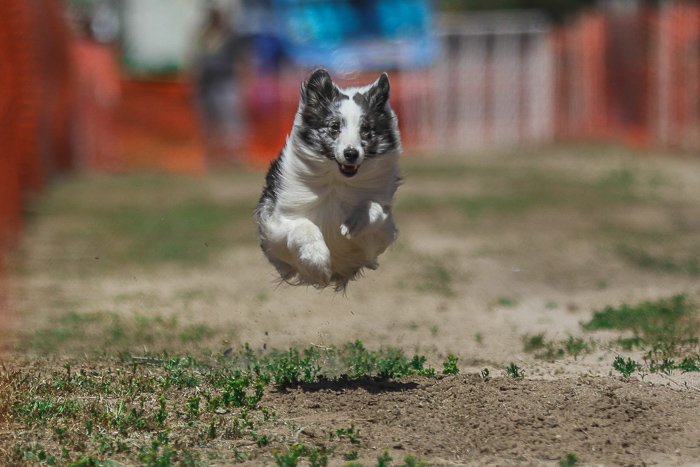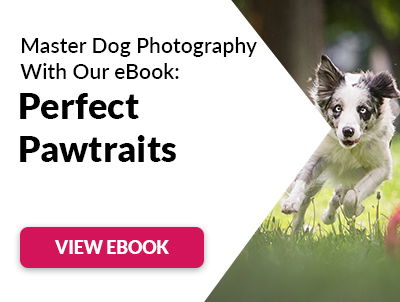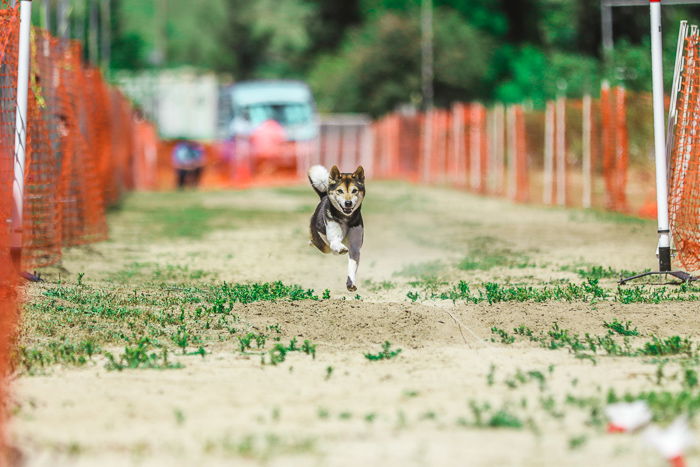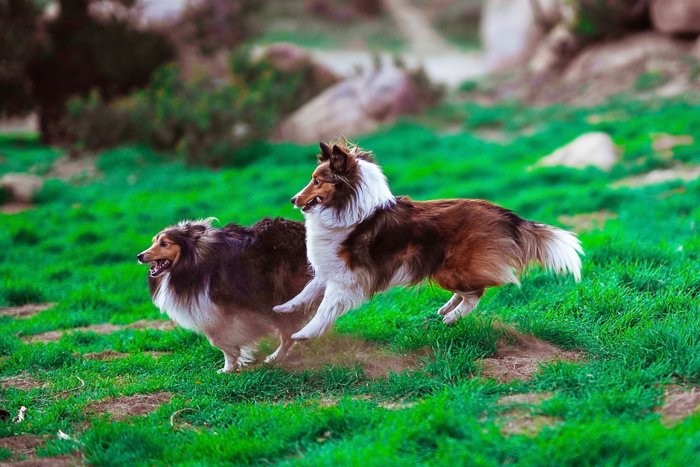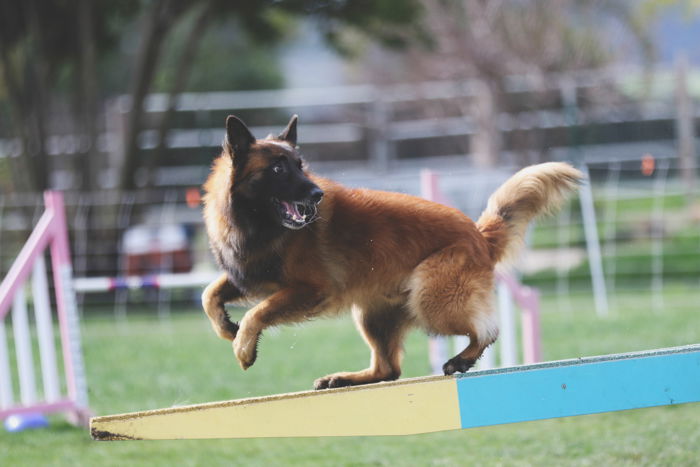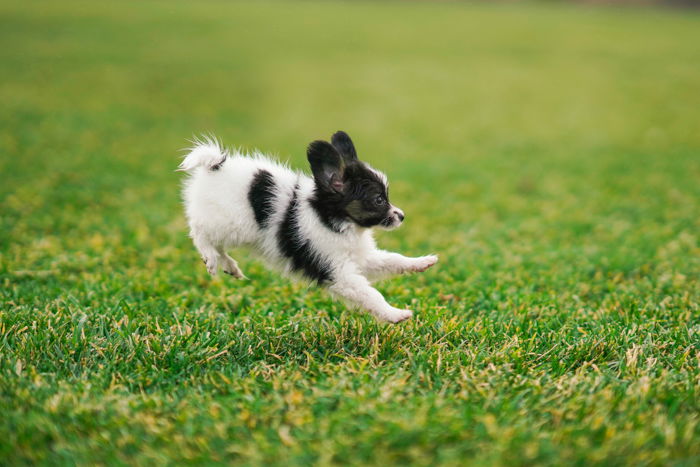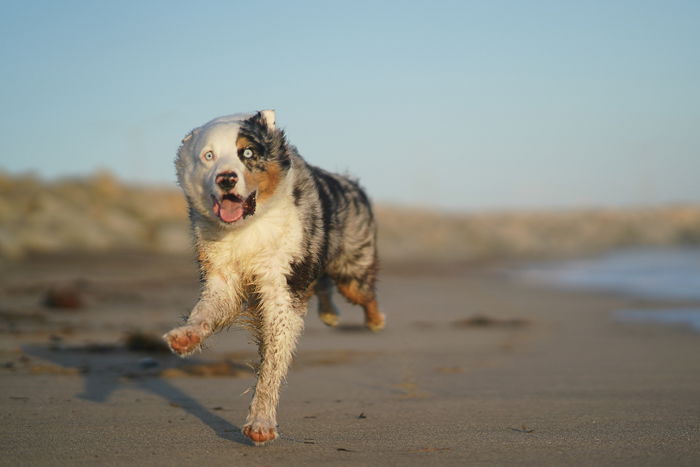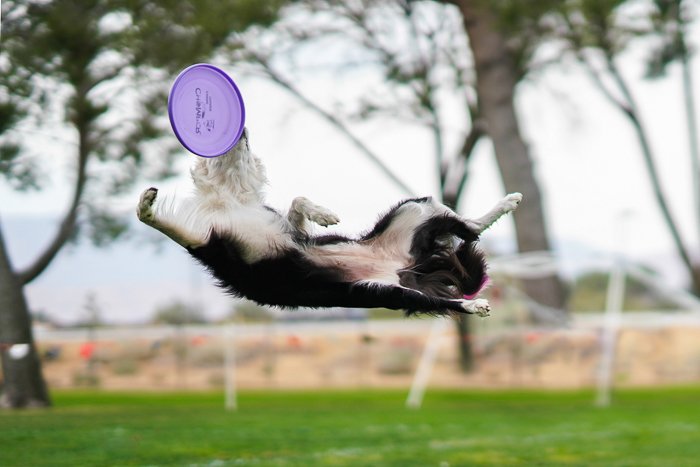What Camera Should You Use for Action Dog Photography?
The camera body means a lot when it comes to action photography. The speed of your camera will determine what moments you can capture. You want to ensure that your shutter closes at the exact second you want it to. Or that it is able to capture an entire sequence of movement. This is what many dog owners love to see from pet action photographers. The frames-per-second, or fps, is how many frames can be shot per second. The more photographs the camera can take, the more steps in an action series you can achieve! The camera is also a significant part of the autofocus system. Each camera has a different autofocus mechanism and number of autofocus points. Autofocus works through a series of selection points. When the subject passes in front of them, they create an outline of what you’re trying to capture. The more autofocus points there are, the more accurate the camera’s selection.
Most action photography happens outdoors, with pups romping in the field. Nature usually happens when you are carrying or using something quite fragile and sensitive. Weather sealing in your camera is pretty important. Weather sealing also helps your equipment last longer. It means your camera can withstand moisture, sand, dirt, debris, snow, hot weather, cold weather, and other such natural troubles that may plague a camera. It is key to note that weather sealing does not mean weatherproof. Your camera may not survive a rainstorm without a waterproof case! To anyone wanting to get very serious into this type of photography, I always recommend purchasing a DSLR. Look for a camera that has a strong inclination towards action photography due to its frames-per-second. Here are some recommendations:
Canon 7D (the 7D Mark II is the newer model – 10 frames per second) Canon 1D-X Mark II (14 fps) Nikon D5 (12 fps) Sony a7R III (10 fps)
Lenses for Dog Photography Action Shots
The key to dog action photography is to interfere as little as possible with the excitement going on. That means shooting from a distance. This way your activity doesn’t distract the dogs from their romping and jumping. Many action photographers work with a telephoto or zoom lens. This allows you to be far enough away from the subject so as to not affect their performance. All while being able to zoom in tightly and capture some beautiful compositions. Finding a lens that has a maximum aperture of f/2.8, or around that range, is a great idea. It will help you isolate the dog from whatever location they are at. Many common outdoor spaces can make a photograph look chaotic due to a number of obstacles in close proximity to your subject. Getting a lens that can shoot at f/2.8 means you can also blur or soften some of the distracting elements in the background.
Something that you should also consider with your lens is the fact that photographing animals in action can be a tumultuous and unexpected endeavor. It’s not uncommon for a lens to get bumped. Some lenses are very sturdy and durable in their build. This makes them relatively shock resistant. What I mean by shock resistance is that they won’t necessarily crumble and break from an accidental bump. My favorite lens for dog action photography is the Canon 70-200mm f/2.8 L IS USM II. I have seen many other photographers inclined toward the 300mm or 400mm range. They use these lenses to get even closer to the dogs without needing to get in the way physically. If you’re not terribly far away, some fixed lenses like the 85mm f/1.4 or 135mm f/1.4 are great choices too.
Why a Telephoto or Zoom Lens Is Going to Be Your Best Friend
Many dogs are very easily distracted with camera equipment. They will stop whatever they are doing to check out whatever you are doing. This doesn’t bode well when you want to capture an awesome shot of a puppy jumping. The solution is quite simple: use a telephoto or zoom lens instead! Hiding is the key to catching those exciting and speedy moments. When it comes to pet photography, sometimes the best shots are those in which you play no role. With the length of the telephoto lens, you can sit very far back. The animal doesn’t even need to know you’re there. Whether you have a fixed millimeter or a variable focal length, you’ll be able to pick out your subjects at their finest. As well as that, one of the key highlights of telephoto and significantly zooming lenses is the fact that they produce a natural perspective (minus the incredible zoom). Lenses that have no distortion are some of the easiest lenses to use. You do not have to factor in any form of misrepresentation due to curved glass. When you can take a picture of something exactly as your eye sees it, the composition becomes easier as well.
Settings for Capturing Pets in Action
Your settings will make a noticeable difference in your ease-of-shooting. Besides needing to shoot with a very fast shutter speed to freeze the action (1/1000th at a minimum but I personally like to shoot at 1/3000th and faster), there are a few other things you can do to get sharp images. Many new cameras have new autofocus mechanisms that make action shooting easier. What the majority of new and old cameras have in common in regards to settings are focus and burst modes (drive mode). First, change your focus mode to Continuous Focus Mode (AI Servo for Canon users or AF-C for Nikon users). This mode allows your camera to lock onto your subject and follow the dog around as it moves. You won’t have to constantly refocus. Where new technology comes into play are the additional customizations for this mode. Some new cameras allow you to either use the Continuous Focus Mode presets or make your own that pertain to what you are shooting. On the Canon 5D Mark IV, you can tell the camera how your subject moves and what obstacles may be present. To do this, you can adjust the various levels of sporadic movement, obstacle interference, and more.
There are even presets for erratically moving subjects and following the subject despite obstacles getting in the subject’s way. I usually tell the camera that my subjects are moving erratically in multiple directions and that there are many obstacles in the way when photographing canine sports. When capturing a dog running in a field, I ease up on the obstacle interference and focus on speed. In cameras that do not have this feature, your AI Servo (AF-C) is still a good focusing mode choice. Next, take advantage of the frames-per-second your camera offers by using burst mode (high-speed drive mode). You can ensure that you get the right shot by setting your camera to burst mode. This is where you take multiple photographs in a row while pressing down on the shutter. Shoot with a fast shutter speed to freeze the action. Like I mentioned previously, competitors love sequence shots. The only way to get these cool sequences is by shooting in burst mode!
Pre-Focus on the Dog and Don’t Let Go
What a title for a tip isn’t it? The best method of capturing action is to pre-focus on the dog even when the dog is not yet moving. In this way, you’re telling the camera what it is that you need to hold focus on. Then, when the dog begins to move, keep following the pup while keeping the focus locked! On the majority of cameras, locking focus is as simple as holding the shutter button down halfway. That being said, cameras are not sentient beings (which makes them not very intelligent). Digital cameras and mirrorless cameras are just machines with a program telling them what to do. Don’t rely entirely on your autofocus for perfectly sharp shots. Keep an eye out for when the camera loses focus on your subject and quickly reset the focus!
Techniques for Taking Action Shots With Dogs
Use Panning to Capture More Interesting Shots
Partnered with your gear and your camera settings, your shooting technique will make or break your results. Be prepared to practice the art of panning. Panning is moving your camera horizontally with the subject’s movement. You synchronize your camera movement with that of the subject moving parallel to you. I find it easiest to focus on the dog while it is waiting to be released by the owner and then follow the dog. Use your best judgment on where you think the dog is going to go. This takes practice, but nothing comes without practice! If the dog is running towards you, most modern continuous focus modes will be able to refocus on them. Don’t rely on this exclusively though. Check focus and refocus on your subject throughout their movement! Alongside panning, another tip to get the most dynamic actions shots is to photograph from the subject’s eye level. Be prepared to spend a lot of time on your knees. This allows viewers to relate to the subject. And it gives them an idea of the height the dog is moving at which aids in how dramatic the photograph appears.
Leave More Negative Space in Your Compositions to Create Movement
Composition really is the driving force in great action photography. Composition is the arrangement of subjects and elements in a frame. The best photographers have a natural sensitivity to proper placement in images. But there are really important compositional elements that you should always keep in mind when photographing. For action, in particular, leave more negative space (empty space) in the direction of the implied movement. Although a photograph is a still moment frozen, the viewer can still imagine the next step in the series. To make sure that the audience can feel the subject bouncing off of the photograph is, leave enough negative space in the direction that you expect the subject to continue moving in. If the subject is too closed off compositionally (by being cropped in such a way that there is little negative space) the image will feel claustrophobic and caged.
Don’t Be Afraid to Direct the Dog’s Owner or Encourage the Pup to Be Athletic
Many client sessions happen on a time schedule. Unless you’re photographing a canine sporting event, you’re likely on a bit of a time crunch. It’s alright to not wait for a pup to want to run and jump and actually direct the owner to encourage the dog to do so! The best way is to usually rile the dog up with a toy and playing fetch. If you rile the dog up enough, they might even get the zoomies and run around like crazy!
Keep an Eye on the Pet’s Well-Being During the Shoot
Photography should be a pleasant experience for everyone involved- the four-legged subject as well! Not all animals are okay with cameras, and they can’t run and play indefinitely. If you see the animal showing distress or anxiety signals, give it a break. Much like children and adult humans, pets get tired and agitated. Instead of letting the animal get to that point, the moment you see a dog get very tired or frustrated, instruct the owner to remove the furry one from the situation and let it take a break. A half hour break is usually an excellent span of time. Sometimes the problems stem from the pet owner. Animals are very sensitive to emotions in others, and if the owner is acting anxious or frustrated, the pet will respond to that. If you witness your client becoming irritated with their pet, try to calm the owner down. If you don’t, the animal you’re photographing will be affected. You can definitely see when a pet isn’t having a great time in photographs, and the whole point of action photography is to see some playful fun. Now go out there and capture some incredible action shots, highlighting pups at their best! For more great photography tips, why not check out our posts on capturing the decisive moment in photos or using freelensing technique!
